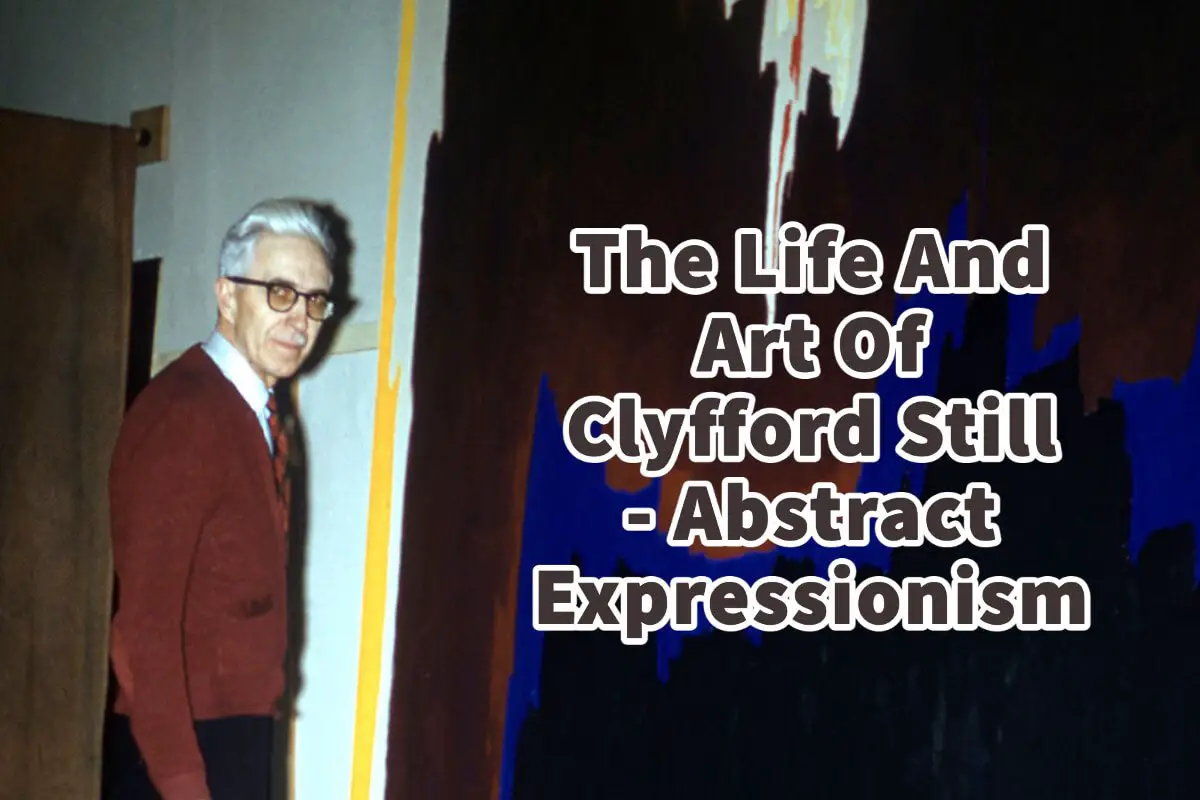Clyfford Still is one of the most misunderstood American artists. Yet he is also one of the most important 20th Century Artists.
Clyfford Still is considered one of the greatest abstract expressionist artists. But like many other abstract expressionist artists, many do not know much about his life or artwork. He did not sell many of his pieces during this lifetime, yet many considered him one of the greatest American artists.
Table of Contents
The Life Of Clyfford Still
Clyfford Still (1904 – 1980) is one of the most influential American artists to live during the 20th century. Clyfford Still, Jackson Pollock, Mark Rothko, Willem de Kooning, and Barnett Newman are considered founders of the Abstract Expressionism art movement.
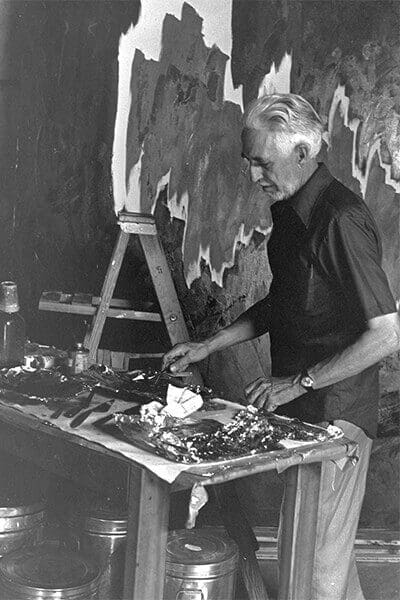
These artists helped change the world’s art centers from Paris to New York City after World War II. They changed artistic tradition and created a new art movement known as Abstract Expressionism.
Clyfford Still was born in Gradin, North Dakota. When he was one year old, his family moved to Eastern Washington State. His father was a farmer, but Clyfford Still was interested in art at an early age. As a farmer’s son, Still remembers how hard he had to work on the farm and was determined not to have to live and work on a farm.
While he was in high school, he showed talent and promise that he was awarded an art scholarship to Spokane University; he graduated from the university in 1933.
He started to teach at Washington State College, now Washington State University in Pullman. While at the university, he obtained a Master’s Degree in Fine Arts. While teaching at Pullman, he met his second wife, Patricia, one of his art students.
Clyfford Still also taught at the California School of fine arts from 1946 to 1950, now the San Francisco Art Institute. While he was there, he became a highly influential professor.
In the 1950s, he moved to New York City with his future second wife, Patti Alice Garske. He was still married then, but his wife Liliana and he were separated; they divorced in 1954. In 1957, Clyfford married Patricia Alice Garkske, also known as Patti; she was his former student and 16 years younger than him.
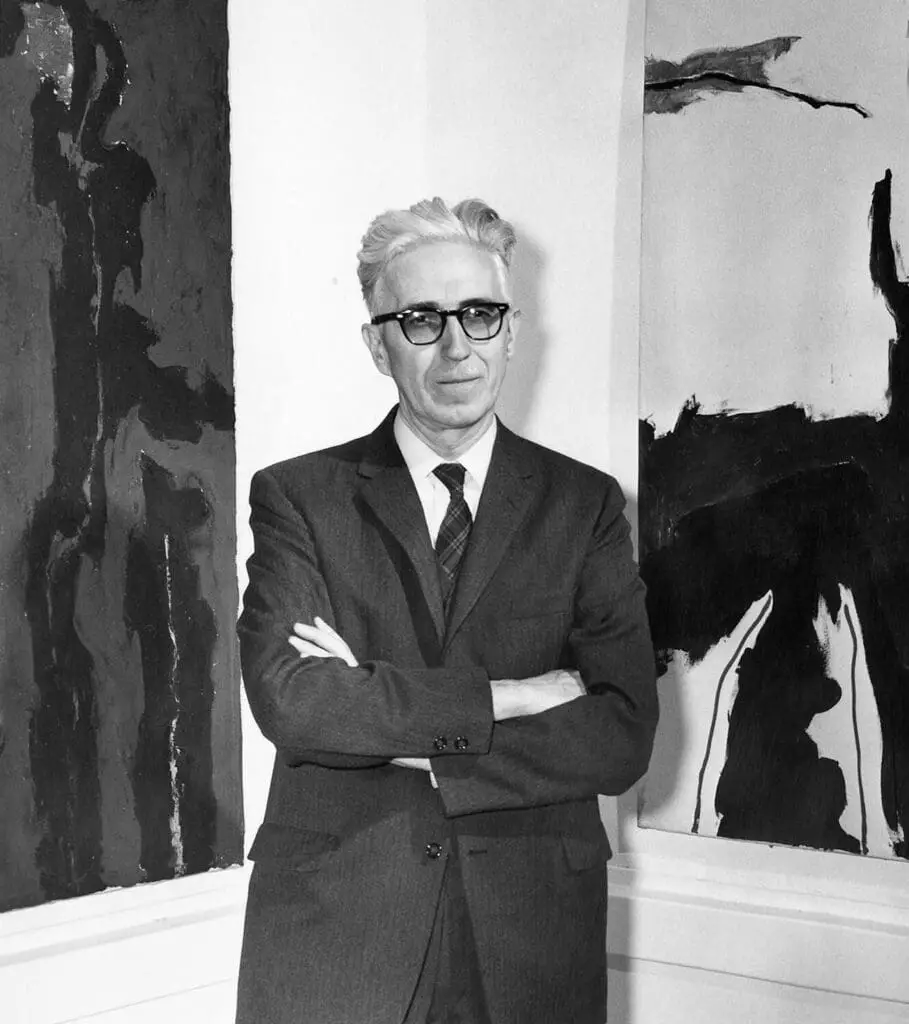
In 1961, Still and Patti moved to a 22-acre farm near Westminister (New Windsor), Maryland. This further removed Clyfford Still from New York City and what was now the center of the art world. But it also gave him a barn and a location where he could easily paint many large-scale paintings.
Clyfford Still and Patti lived in this area until their death. Clyfford Still died in 1980, and Patti Still in 2005.
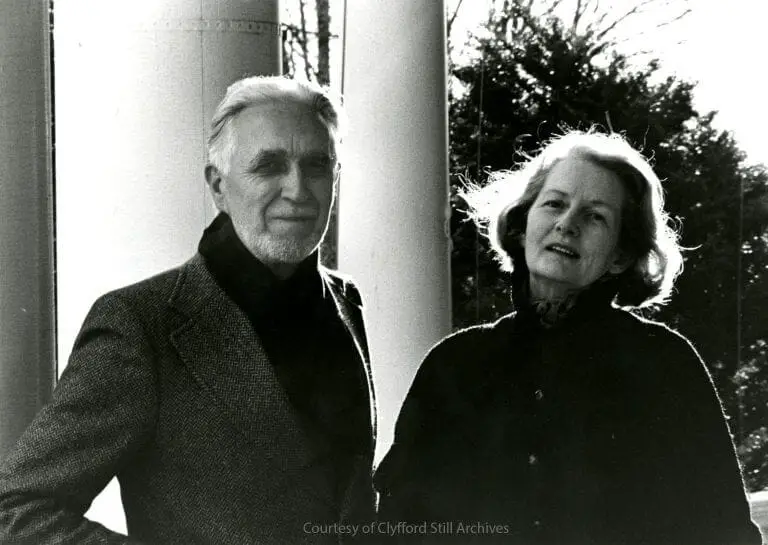
The Art Of Clyfford Still
Clyfford Still is an Abstract Expressionism painter who is known to be part of the color field movement of abstract expressionism. He is one of the first generations of abstract expressionists who developed a new and powerful approach to painting; this new approach to art would influence art and the world for many years.
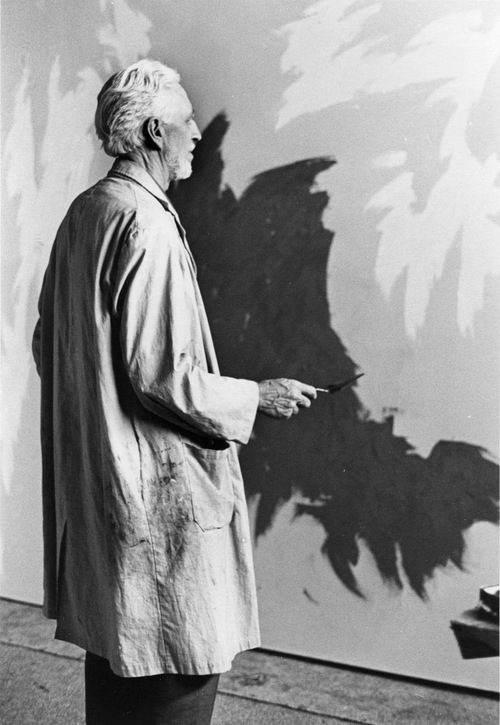
Clyfford Still developed his unique signature style in San Francisco between 1946 and 1950 while teaching at the California School of Fine Arts in San Francisco (now the San Francisco Art Institute).
Still’s paintings are unique because they interlock jagged edges on large-scale canvases. He applied the paint with a palette knife.
Gradually, he would increase the size of the shapes and the size of his canvas as he wanted the viewers to be enveloped in a massive field of color – or pure sensation and saturation of color.
Like many other color field painters in Abstract Expressionism, Clyfford Still wanted the art to speak for itself because the paintings were about helping to present a contemplative or meditational response to the viewers.
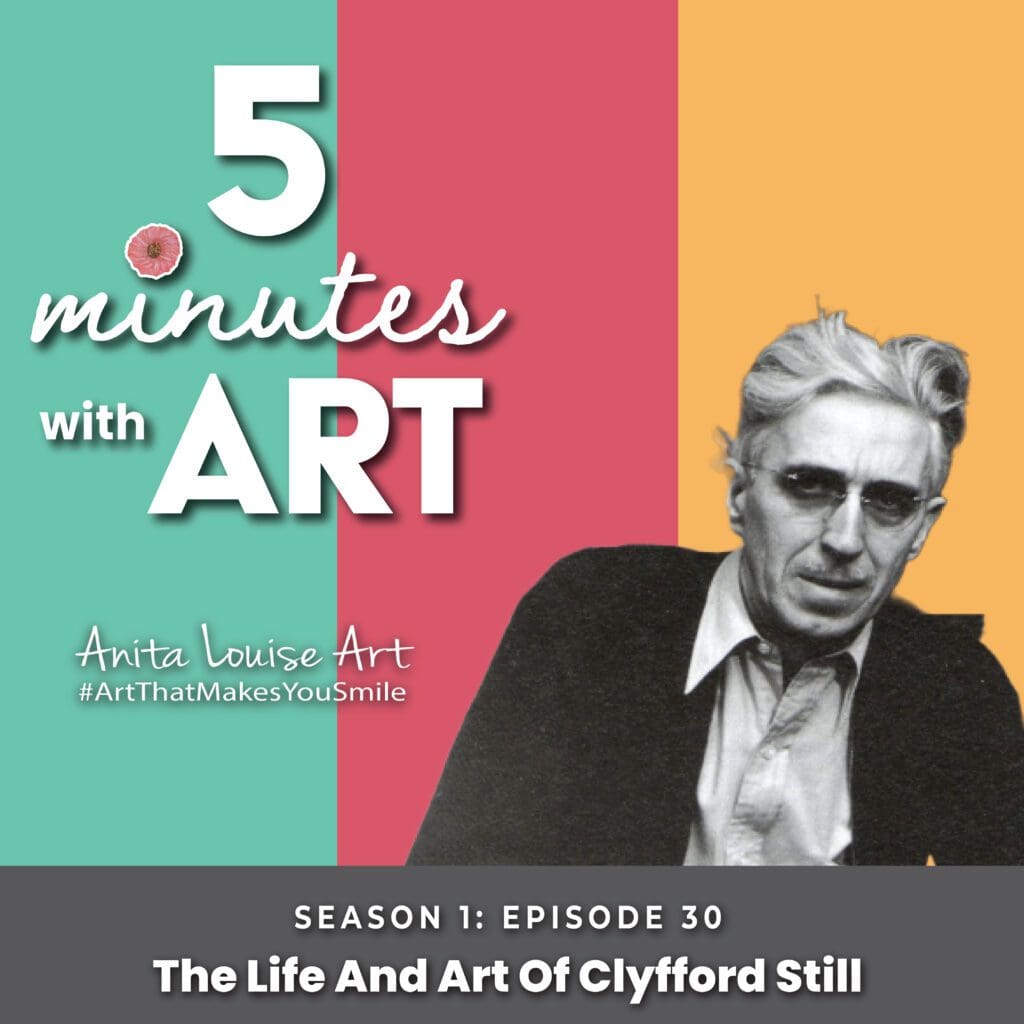
Listen To Our Podcast About The Life And Art Of Clyfford Still by clicking here.
Clyfford Still influenced many other Abstract Expressionism painters, including Jackson Pollock, Mark Rothko, and Barnett Newman.
Jackson Pollock once famously said this about Clyfford Still:
“Clyfford Still makes the rest of us all look academic.”
Jackson POllock
Clyfford Still did not have much time and respect for many other artists. He is known to have called Barnett Newman “pathetic” and the Pop Artist Andy Warhol a “cartoonist.” One Abstract Expressionist painter that he did like was Jackson Pollock.
Right before Pollock died, Still and Pollock were supposed to go on a cross-country trip together (driving separate cars). Pollock never showed up at the designated time and place so Clyfford Still continued on the trip. While traveling through Wisconsin, he read about Pollock’s death and said,” if he’d come, he might still be alive today.”
It was not just other artists that Clyfford Still did not have time for, but also art critics. He called them “arrogant” and” stupid” people who judged his artwork. Because of his disdain for the establishment, Clyfford Still was extremely picky about who could get one of his paintings and how they would be displayed.
When Still died, most of his art was still at his home in Maryland. His estate had over 2,400 works of art that were sealed off entirely from public view for over twenty years. The works were just stored there by his wife, Patti.
In his will, he wrote this about what he wanted to have done with his artwork:
“I give and bequeath all the remaining works of art executed by me in my collection to an American city that will agree to build or assign and maintain permanent quarters exclusively for these works of art and assure their physical survival with the explicit requirement that none of these works of art will be sold, given, or exchanged but are to be retained in the place described above exclusively assigned to them in perpetuity for exhibition and study.”
Clyfford Still – Will
Many cities wanted his artwork, but In 2004, the City of Denver announced it had been chosen by Patricia Still to receive the artwork and estate of Clyfford Still.
The Clyfford Still Museum opened in November 2011. Today, you can see most of Clyfford Still’s artwork at The Clyfford Still Museum in Denver, Colorado.
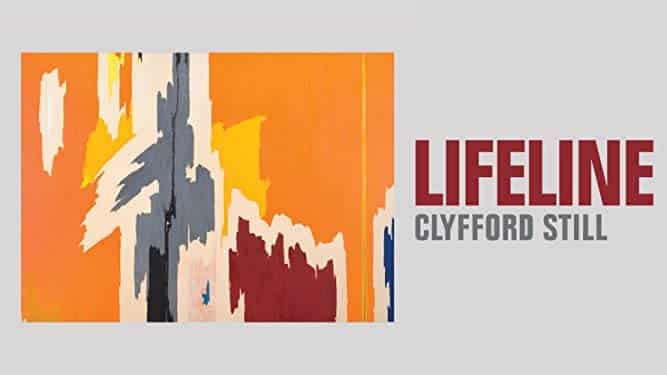
In 2019, a new documentary called Lifeline/Clyfford Still offered an unbiased view of this great artist, his personal life, and his art. The documentary is worth watching to learn more about Clyfford Still. You can find out more about the documentary by clicking here.
Anita Louise Art is dedicated to art education, great artists, and inspiring others to find and create their art. We love art that uplifts and inspires. #ArtToMakeYouSmile! #ArtToMakeYouHappy!
If you want to see any of my art, you can find out more by clicking here. If you are interested in what inspires me and my paintings, you can discover more by clicking here.
We have a free newsletter and would love you to be part of our community; you can subscribe to the newsletter by clicking here. I would be happy to talk to you if you have any questions. You can reach me, Anita, by clicking here.
Subscribe to our Anita Louise Art YouTube Channel with great videos and information by clicking here.
Join us for our podcast “5 Minutes With Art.” Spend just 5 minutes a week with us to discover and learn about great art and artists. You can find out more about our podcast by clicking here.
Frequently Asked Questions
Who is Clyfford Still, and why is he considered an important figure in American art?
Clyfford Still (1904-1980) was an influential abstract expressionist artist known for his monumental and emotive paintings. He is considered important for his significant contributions to the abstract expressionist movement, reshaping the landscape of American art in the mid-20th century.
What is Abstract Expressionism, and how does Clyfford Still’s work fit into this art movement?
Abstract Expressionism is an art movement characterized by the spontaneous and expressive application of paint. Clyfford Still’s work is closely associated with this movement, particularly due to his large, non-representational canvases that conveyed intense emotions and a sense of the sublime.
Why is Clyfford Still often referred to as a misunderstood artist?
Still’s work was complex and challenging, often leading to a lack of understanding among the general audience. His rejection of traditional artistic norms and his intensely personal approach to art made it difficult for some to appreciate and interpret his creations.
Did Clyfford Still gain recognition during his lifetime, or did his success come posthumously?
Although Still did not achieve widespread commercial success during his lifetime, his reputation grew posthumously. The Clyfford Still Museum, opened in 2011, played a crucial role in showcasing his work and contributing to a greater understanding and appreciation of his artistic legacy.
Why did Clyfford Still choose not to sell many of his paintings during his lifetime?
Still was known for his disdain for commercialism in art. He was highly selective about selling his work, preferring to maintain control over how his art was displayed and interpreted. This approach limited his financial success during his lifetime.
What distinguishes Clyfford Still’s paintings from those of other abstract expressionists?
Still’s paintings are often characterized by their monumental scale, use of bold colors, and jagged, dynamic forms. His unique approach to abstraction, which involved creating compositions that seemed to emerge organically, set his work apart from other abstract expressionists.
How did Clyfford Still’s early life and experiences influence his artistic style?
Still’s early life, growing up in the American West and experiencing the harsh landscape, had a profound impact on his artistic sensibilities. The vastness and intensity of nature influenced the scale and emotional depth of his later paintings.
What is the Clyfford Still Museum, and why is it significant in preserving his legacy?
The Clyfford Still Museum, located in Denver, Colorado, is dedicated solely to the works of Clyfford Still. It houses the majority of Still’s estate, providing a comprehensive view of his artistic development and serving as a key institution for the study of abstract expressionism.
How did Clyfford Still’s artistic philosophy differ from his contemporaries in the abstract expressionist movement?
Still was known for his individualistic and somewhat reclusive nature. Unlike some of his peers, he avoided artistic manifestos and did not align himself with any specific art movement. His focus on individual expression and the purity of the artistic gesture set him apart from others in the abstract expressionist circle.
Related Questions
What Art Movements Emerged From the New York School?
One of the major movements that emerged from the New York school was Abstract Expressionism. This is a significant art movement that started after World War II. Another art movement that is credited with starting in New York City is Minimalism.
By clicking here, you can learn more by reading What Art Movements Emerged From the New York School?.
Why Did New Art Movements Develop In The Years Following World War 1?
Many of the art movements after World War 1 came about as a direct protest about the devastation and loss of human life in the First World War. Many of these art movements also included cultural and political movements where like-minded artists band together to produce satirical and other art.
You can discover more by reading Why Did New Art Movements Develop In The Years Following World War 1? by clicking here.
Can Anyone Be An Abstract Artist Without Any Talent In Painting?
To be a great abstract artist need, you need talent and an understanding of painting. Painting can be a technical skill that artists spend a lifetime perfecting through their art education and practice. Great abstract artists have had intensive training in painting, drawing, composition, and color theory.
You can learn more by reading Can Anyone Be An Abstract Artist Without Any Talent In Painting? by clicking here.

